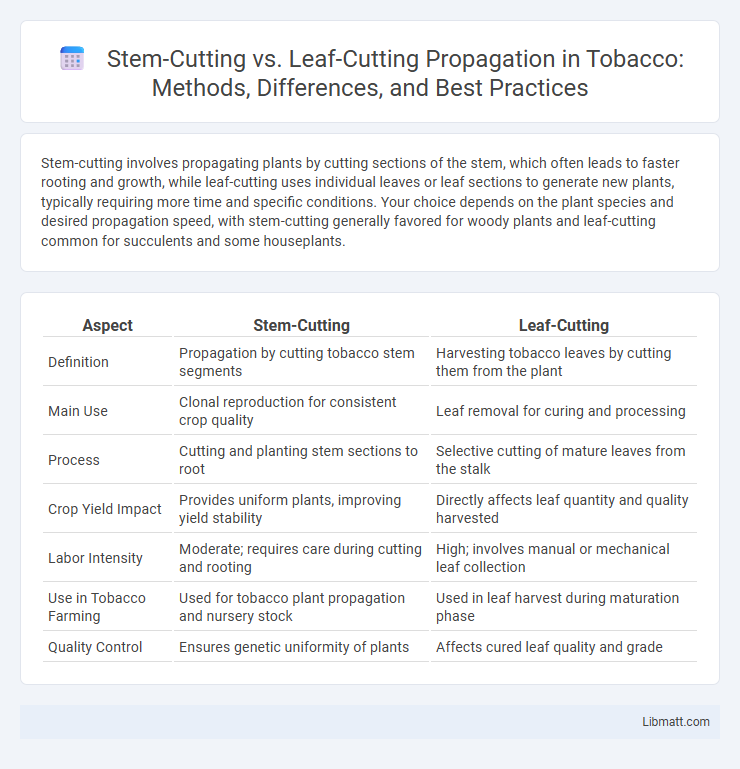Stem-cutting involves propagating plants by cutting sections of the stem, which often leads to faster rooting and growth, while leaf-cutting uses individual leaves or leaf sections to generate new plants, typically requiring more time and specific conditions. Your choice depends on the plant species and desired propagation speed, with stem-cutting generally favored for woody plants and leaf-cutting common for succulents and some houseplants.
Table of Comparison
| Aspect | Stem-Cutting | Leaf-Cutting |
|---|---|---|
| Definition | Propagation by cutting tobacco stem segments | Harvesting tobacco leaves by cutting them from the plant |
| Main Use | Clonal reproduction for consistent crop quality | Leaf removal for curing and processing |
| Process | Cutting and planting stem sections to root | Selective cutting of mature leaves from the stalk |
| Crop Yield Impact | Provides uniform plants, improving yield stability | Directly affects leaf quantity and quality harvested |
| Labor Intensity | Moderate; requires care during cutting and rooting | High; involves manual or mechanical leaf collection |
| Use in Tobacco Farming | Used for tobacco plant propagation and nursery stock | Used in leaf harvest during maturation phase |
| Quality Control | Ensures genetic uniformity of plants | Affects cured leaf quality and grade |
Introduction to Plant Propagation Methods
Stem-cutting involves taking a section of a plant's stem with nodes to encourage root growth, making it ideal for woody or herbaceous plants like roses and mint. Leaf-cutting propagation uses individual leaves or leaf sections, commonly applied to succulents and plants such as African violets, promoting new plants from leaf tissue. Both methods are vital in horticulture for cloning plants efficiently, preserving genetic traits and accelerating growth cycles.
Understanding Stem-Cutting Propagation
Stem-cutting propagation involves using sections of a plant's stem to grow new roots and develop into a separate plant, making it a reliable method for cloning many woody and herbaceous species. Unlike leaf-cutting, which uses leaves that often require specific conditions to root successfully, stem-cuttings contain nodes where roots can easily form, improving propagation success rates. You can increase your plant propagation efficiency by selecting healthy stem segments with multiple nodes and ensuring proper moisture and temperature conditions.
Exploring Leaf-Cutting Propagation
Leaf-cutting propagation involves using healthy leaf segments to generate new plants, offering an efficient and low-risk alternative to stem-cutting methods. This technique is especially beneficial for succulents and certain houseplants, where leaf cuttings can root and develop new shoots without the need for woody stems. By mastering leaf-cutting propagation, you can expand your garden with minimal resource input while ensuring genetic consistency in your plants.
Key Differences Between Stem-Cutting and Leaf-Cutting
Stem-cutting involves propagating plants through segments of the stem containing nodes, allowing for quicker root development and stronger plant structure, while leaf-cutting uses individual leaves or leaf sections, which may take longer to root and grow. Stem-cutting is commonly preferred for woody plants and shrubs, providing higher success rates, whereas leaf-cutting suits herbaceous plants and succulents with simpler root initiation. Your choice depends on the plant species and propagation goals, with stem-cutting offering more reliable cloning of mature characteristics.
Suitable Plant Species for Stem-Cutting
Stem-cutting is particularly suitable for woody plants such as roses, hibiscus, and bougainvillea, where mature stem sections can readily develop roots. This propagation method is effective for herbaceous plants like coleus or geranium, which produce strong, healthy shoots ideal for cutting. In contrast, leaf-cutting is limited to species like succulents and African violets that can regenerate entire plants from leaf tissues.
Ideal Plants for Leaf-Cutting Propagation
Ideal plants for leaf-cutting propagation include succulents like jade plants (Crassula ovata) and African violets (Saintpaulia), as their leaves readily produce roots and new growth. Houseplants such as begonias and peperomias also respond well to leaf-cutting, making them popular choices for efficient and low-resource propagation. Choosing plants with thick, fleshy leaves enhances success rates due to their inherent water storage capacity and nutrient reserves.
Step-by-Step Guide: Propagating with Stem-Cuttings
Propagating plants with stem cuttings involves selecting a healthy stem, typically 4-6 inches long, and making a clean cut just below a node using sterilized pruning shears. Remove the lower leaves to expose the nodes, dip the cut end in rooting hormone to encourage root development, and plant it in a well-draining propagation medium such as a mix of peat and perlite. Keep the cutting in a humid environment with indirect light and consistently moist soil until roots develop, which usually takes 2-4 weeks, ensuring Your new plant establishes successfully.
Step-by-Step Guide: Propagating with Leaf-Cuttings
Propagating plants via leaf-cuttings involves carefully selecting a healthy leaf, cutting it at the base, and allowing it to callous over for a few days to prevent rot. You then plant the calloused leaf in a well-draining soil mix, keeping the medium moist and providing indirect sunlight to encourage root and new plant growth. This method differs from stem-cutting, which requires a longer stem portion and often demands more precise timing and hormone application for successful propagation.
Advantages and Challenges of Each Method
Stem-cutting promotes faster root development and better structural strength in propagated plants, making it ideal for woody species and ensuring higher survival rates. However, it requires careful handling to prevent fungal infections and can be more labor-intensive due to the need for precise cutting and treatment. Leaf-cutting offers a simple, cost-effective propagation method suitable for herbaceous plants and allows for mass propagation, but it faces challenges such as slower root initiation and higher susceptibility to dehydration and disease.
Choosing the Best Propagation Technique for Your Plants
Stem-cutting propagation promotes faster root development and is ideal for woody plants like roses and hibiscus, ensuring genetic consistency and robust growth. Leaf-cutting suits succulent varieties and certain houseplants, offering a simple, space-efficient method though with slower or less reliable rooting. Assess your plant type and growth goals to select the best technique, maximizing your propagation success and plant health.
stem-cutting vs leaf-cutting Infographic

 libmatt.com
libmatt.com